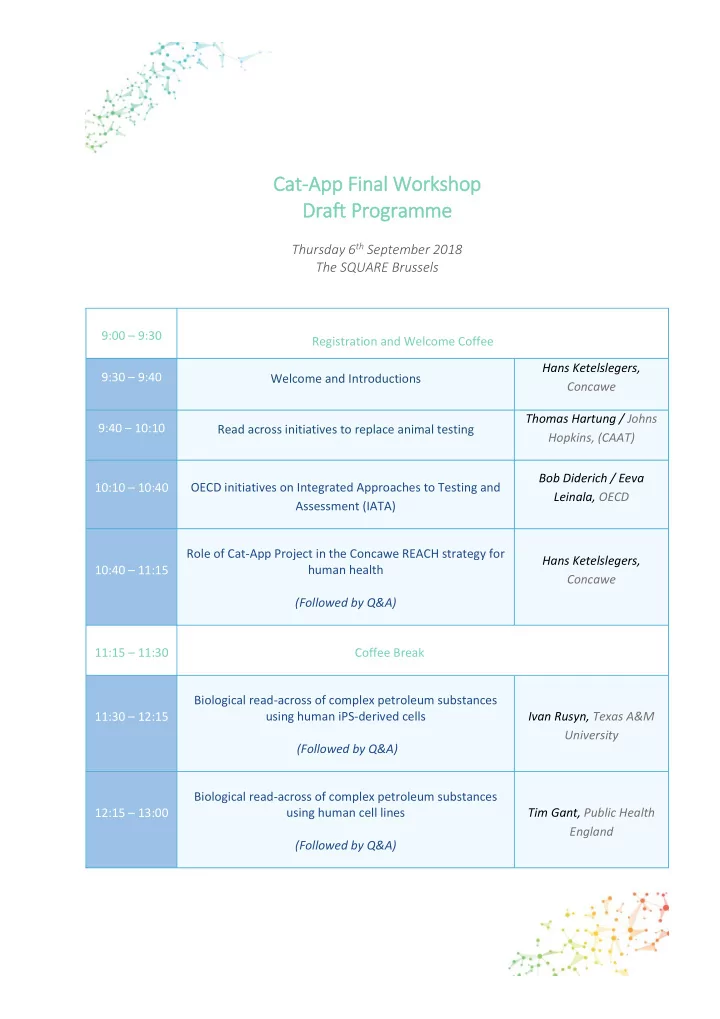

Cat at-App Fin inal l Workshop Draft t Programme Thursday 6 th September 2018 The SQUARE Brussels 9:00 – 9:30 Registration and Welcome Coffee Hans Ketelslegers, 9:30 – 9:40 Welcome and Introductions Concawe Thomas Hartung / Johns 9:40 – 10:10 Read across initiatives to replace animal testing Hopkins, (CAAT) Bob Diderich / Eeva 10:10 – 10:40 OECD initiatives on Integrated Approaches to Testing and Leinala, OECD Assessment (IATA) Role of Cat-App Project in the Concawe REACH strategy for Hans Ketelslegers, 10:40 – 11:15 human health Concawe (Followed by Q&A) 11:15 – 11:30 Coffee Break Biological read-across of complex petroleum substances 11:30 – 12:15 using human iPS-derived cells Ivan Rusyn, Texas A&M University (Followed by Q&A) Biological read-across of complex petroleum substances 12:15 – 13:00 using human cell lines Tim Gant, Public Health England (Followed by Q&A)
13:00 – 14:00 Lunch Gene expression connectivity mapping and its application in Shu-Dong Zhang, 14:00 – 14:30 Cat-App University of Ulster (Followed by Q&A) Data Science: Integrative data analysis and visualization for 14:30 – 15:15 chemical-biological read across Fred Wright, North Carolina State University (Followed by Q&A) 15:15 – 15:30 Coffee Break Replacement of animal testing with new approach 15.30 – 16:00 methodologies: Where are the opportunities? Animal rights representatives (TBC) (Followed by Q&A) Cat-App: New approach methodologies in a regulatory context 16:00 – 16:30 George Daston, Procter & Gamble (Followed by Q&A) Future perspectives 16:30 – 16:45 Peter Boogaard, Shell Hans Ketelslegers, 16:45 – 17:00 Overall discussion and wrap-up Concawe 17:00 – 18:30 Cocktail Reception Programme and speakers might be subject to change.
Background information on the Cat-App Project The overall obje ject ctive of the multi-year, transatlantic Cat-App research consortium was to develop a framework supporting the Concawe strategy for human health assessment of complex petroleum substances to meet the regulatory requirements under the REACH 1 legislation. Petroleum substances are prototypical examples of UVCB 2 materials, which are a particular challenge for science-informed regulatory decision making: given the complexity of these products, current alternative strategies provided in specific regulations, mainly focusing on read across approaches, cannot be applied to petroleum UVCBs. In addition, taking animal welfare considerations, time and testing cost into account, it is practically unfeasible to address hundreds of petroleum products with conventional toxicological guideline studies in animals. The Cat-App framework aims to address this, by applying state of the art technical, statistical and transparent data communication methods to make best use of all available data in an integrative way - facilitating chemical-biological grouping and read across of these and other complex substances. In addition, this framework should be the basis of an intelligent testing strategy, leading to a significant reduction in the use of test animals for the cost- and time effective toxicity testing of petroleum products by concentrating efforts on specific targets where no or insufficient data are available. This work should eventually lead to a more sustainable way for the industry to screen for potential health risks related to the production, transport and use of petroleum products for workers and the population at large The Spec ecific fic Res esults ts achieved: • A framework for high-throughput chemical-biological read across of UVCB substances by combining multiple streams of information (production type/refining process, physico-chemical properties, analytical compositional data and a comprehensive array of the biological/toxicological data in a broad spectrum of in vitro assays); • A demonstration how UVCB substances may be grouped/categorised by the integrative analysis of all these data for the purpose of risk and hazard assessment using petroleum substances as a case study; • A demonstration of how experimental and computational approaches work together to establish a UVCB read across framework which can be applied to a broad spectrum of other complex substances. Join us on 6 th September for the presentation of the final results and to discuss the practical application of these data with various interested stakeholders from academia, industry and regulatory bodies. 1 Regulation (EC) No 1907/2006 of the European Parliament and of the Council of 18 December 2006 concerning the Registration, Evaluation, Authorisation and Restriction of Chemicals (REACH), establishing a European Chemicals Agency. 2 UVCB: Substances of Unknown, Variable composition, Complex reaction products, Biological materials
Recommend
More recommend